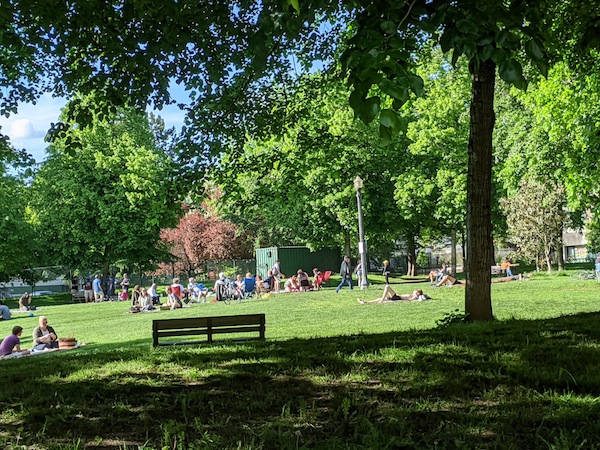בימים אלה חזרתי לקנדה מנסיעה לישראל עייף ומותש. הוראות הקוביד במדינות השונות הפכו את הנסיעה לדבר מסובך, מורכב ובעיקר מעייף. כמובן שזה גם הרבה יותר יקר לטוס בימים אלה. יש לקוות שתקנות הקוביד יבוטלו ונחזור לשגרת חיים רגילה. לדעתי הגיע הזמן להתייחס לקוביד כמו אל כל זן חדש של שפעת. אי אפשר להמשיך במגבלות השונות שנה שלישית ברציפות.
הצטרכתי לטוס מוונקובר לתל אביב בשל אשפוזה של אמי בבית החולים. לאחר מספר ימים שם היא נפטרה ואז נשארתי למסע הלוויה ופרק הניחומים.
רכשתי כרטיס טיסה בקיי.אל.אם מהרגע להרגע והתענוג עלה לי לא פחות מאלפיים ארבע מאות דולר. יצאתי מיד לבצע בדיקת קוביד לפי דרישות מדינת ישראל והתשלום הוא גבוה במיוחד: מאתיים דולר. נדמה לי שקנדה היא המדינה היקרה ביותר במערב בכל הנוגע לבדיקות קוביד עבור אלה שטסים. כיוון שהתוצאות של הבדיקה הובטחו לי בתוך עשרים וארבע שעות לא יכולתי לצאת לכיוון ישראל בעשות הבוקר ולכן נשארה לי רק האופציה של החברה התעופה ההולנדית.
בגלל הביקור החפוז החלטתי שלא לעשות צ’ק אין למזוודה ולקחתי עמי תיק מסמכים ומזוודה קטנה למטוס. למרות זאת נאלצתי לעבור בדלפק של קיי.אל.אם בשדה התעופה שלוונקובר, כדי שיאשרו את כל מסמכי הקוביד: תוצאה שלילית של הבדיקה, הטפסים עבור הכניסה לישראל ואישור שחוסנתי בקנדה כבר שלוש פעמים.
לאחר הטיסה הארוכה שנמשכה למעלה מתשע שעות נחתנו באמסטרדם לעצירת ביניים. בדרך כלל אני יוצא מהשדה אל העיר לאור כך שיש לי כעשר שעות של המתנה עד לטיסה שיוצאת לתל אביב, אך הפעם החלטתי שלא לנהוג כך, כדי שלא אאלץ שוב לאשר את מסמכי הקוביד.
הסתובבתי שעות בשדה, אכלתי לא מעט, שתיתי יין, התקלחתי ואף שכרתי חדר במלון שבטרמינל למספר שעות. למרות זאת נשארתי מאוד עייף, נמנמתי קלות בטיסה לתל אביב שיצאה בסביבות תשע בלילה.
נחתנו בתל אביב בסביבות שתיים לפנות בוקר ולשמחתי שדה התעופה היה כמעט ריק בלילה שבין שישי לשבת. רצתי מייד לבצע בדיקת קוביד שנייה עבור ישראל, שעברה מהר יחסית והייתה הרבה יותר זולה מזו שעשיתי בוונקובר.
יומיים לפני הטיסה בחזרה לוונקובר ביצעתי בתל אביב בדיקת קוביד נוספת, הפעם עבור הממשלה הקנדית. גם היא הייתה הרבה יותר זולה מאשר זו שעשיתי כאן. מילאתי את כל הטפסים הדרושים בעידן הקוביד: טופס יציאה מישראל וטופס כניסה לקנדה. עדכנתי גם את האתר של קיי.אל.אם בכל המסמכים הדרושים ובכן בתוצאת הבדיקה.
עם זאת כשהגעתי לשדה התעופה בתל אביב נדרשתי שוב לאשרר את כל המסמכים. קיוויתי שזה הסוף לטירטורים בעידן הקוביד אך טעיתי בגדול.
עם הנחיתה באמסטרדם נאלצתי שוב לאשרר את כל מסמכי הקוביד עבור קנדה. המתנתי בתור ארוך והפקיד רשם משהו על כרטיס עליה למטוס שלי. כשהגעתי לשער העלייה למטוס התברר שהפקיד לא הוסיף מדבקה המאשרת את המסמכים וצוות הקרקע סירב לאפשר לי להיכנס למטוס. נאלצתי שוב לחפש את אותו פקיד כאשר תור גדול של אנשים עמד לפניו. למזלי אשת צוות קרקע עזרה לי והעבירה לו מיד את כרטיס עלייה למטוס והוא הוסיף את המדבקה המיוחלת. רציתי במהירות לשער העלייה למטוס כי פחדתי שהטיסה תצא אל הדרך.
עם הנחיתה בוונקובר נחתה עלי מכה נוספת: נתבקשתי באופן אקראי לעשות בדיקת קוביד נוספת, רביעית במספר בטיול זה. חוקי הקוביד עייפו אותי עד מאוד בנסיעת חירום זו.





